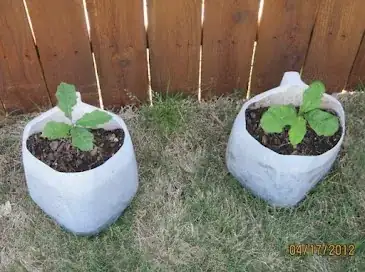There are large number of different red oaks, but, usually, when people say red oak they are referring to Northern red oak (Quercus rubra syn. Q. borealis). A Texan, however, might reasonably use the term to refer to Texas red oak (Quercus buckleyi), Southern red oak (Quercus falcata), or Shumard oak (Quercus shumardii). Most of what follows is widely applicable, so we need not worry which tree we are dealing with.
Acorns should be collected promptly since many types start rotting, drying out or germinating shortly after falling from the tree. Any loose caps or twigs should be removed. The acorns should then be dumped into a bucket of water, and any acorns that float should be discarded.
Acorns do not store well. They quickly dry out and die. Hence if the acorns are being stored for any length of time, put them in a heavy duty sealed plastic bag (4-10 mils) and place in a refrigerator (1-3ºC).
The white oak group, the oaks with smooth lobed leaves, with only a couple exceptions (like Q. macrocarpa), do not require a cooling period to germinate and will germinate in three to five weeks after planting. The black (red) oak group, the oaks with pointy lobed leaves, almost all require a cold period of 30 to 90 days before they will germinate. This can be done in a refrigerator. The acorns can be placed in a plastic bag containing moist sand and peat and then put in a refrigerator (1-5ºC) until the appropriate chill time is reached or the acorns start germinating. Shumard oak has a 30-45 day pre-chilling requirement. Both northern red oak and Southern red oak have a 30-90 day pre-chilling requirement.
The easiest way to germinate acorns, however, is to plant them outside during the fall in a seed bed 6-12" (15-30 cm) apart covered with .25" (0.5 cm) of soil. Members of the white oak group will germinate before winter while the those in the black (red) oak group will germinate in the spring. Both the roots and stems emerge from the pointy part of the acorn, so the most sensible orientation for planting an acorn is on its side.
There is some disagreement on whether to remove the seed coat, or pericarp, from Northern red oak (Q. rubra) before planting. Bonner and Vozzo recommend it:
Dormancy in Q. rubra has also been attributed to the pericarp by Jones
and Brown (1966). They induced germination by removing or clipping the
pericarp and concluded that dormancy was the result of inhibited cell
expansion. Hopper and others (1985) also concluded that the pericarp
was significantly involved in dormancy of Q. rubra, and Bonner (1968)
found pericarps to inhibit germination of four red oak species.
Norman Deno investigated Q. rubra and explicitly disagrees:
Soaking seeds for a week, making a hole in the seed coat, or removing
the seed coats did not increase the rate of gemination or the percent
germination showing that impervious or semimpervious seed coats were
not present nor was there any inhibitors in the seed coat.
Personally, I would not bother. It is likely the pre-chilling required for Northern red oak is sufficient to neutralize any inhibitors present.
References:
First Supplement to the 2nd Edition of Seed Germination Theory and Practice, Norman C. Deno (1996).
Seed Biology and Technology of Quercus, F.T. Bonner and J.A. Vozzo.
Seeds of Woody Plants in North America, J.A. Young and C.G. Young (1992).
